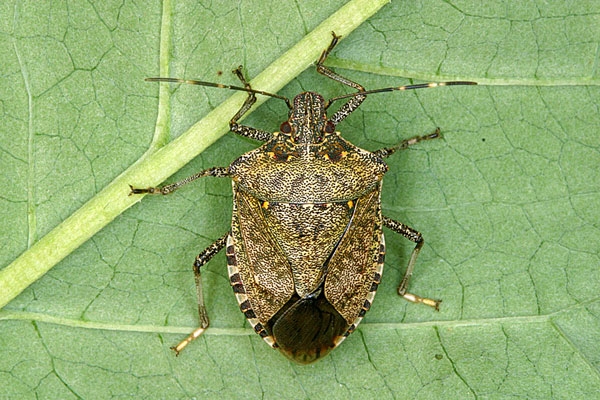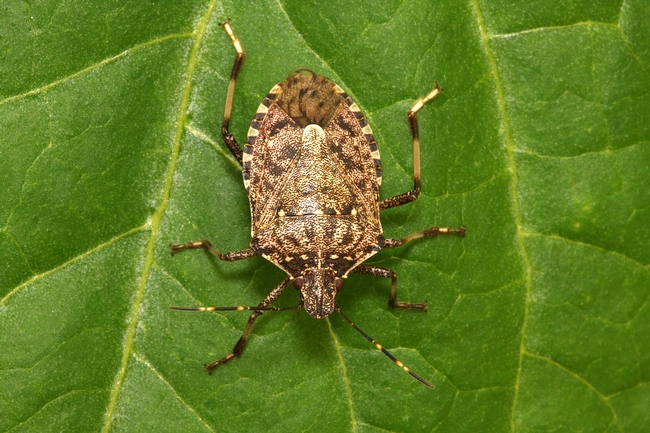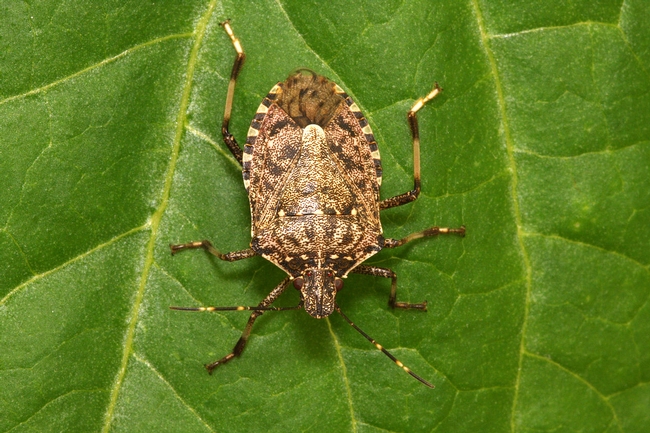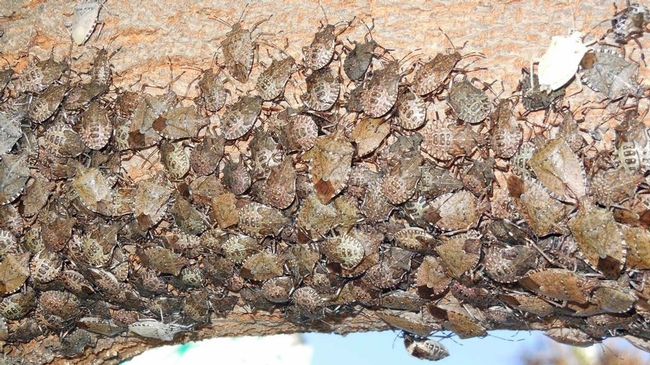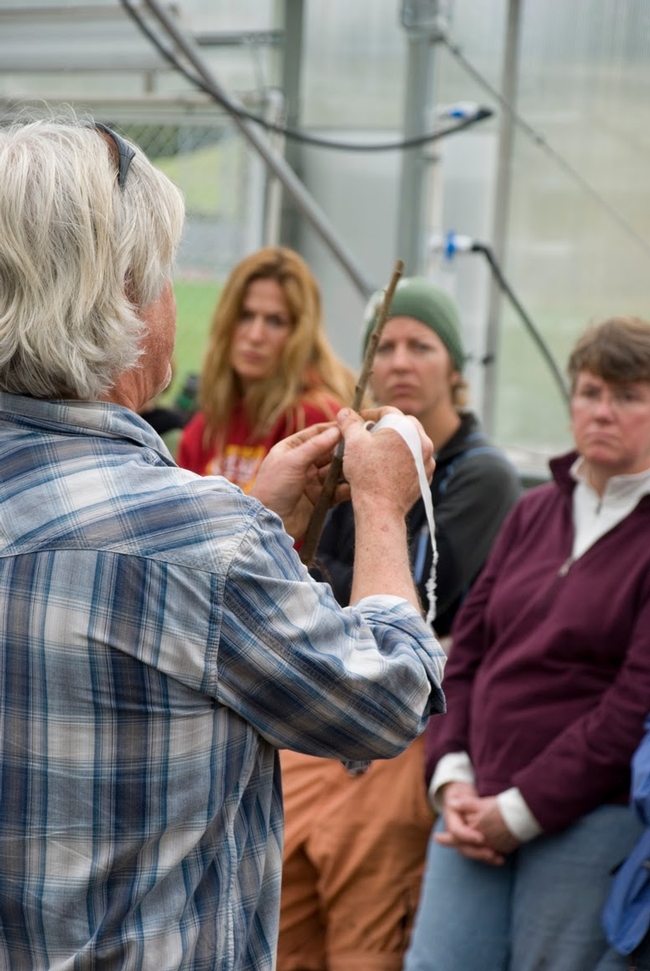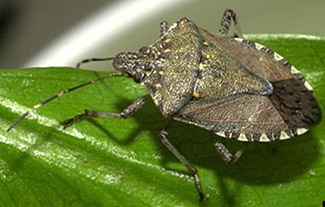Posts Tagged: brown marmorated stink bug
Invasive stink bugs found in Stanislaus County
The brown marmorated stink bug (BMSB) has made its way to Stanislaus County, reported John Holland in the Modesto Bee. The invasive pest, introduced into the U.S. from Asia, has also been detected in San Joaquin, Sacramento, Yolo, Sutter, Butte, Santa Clara and Los Angeles counties.
The stink bugs pose a threat to a wide variety of plants, including home-grown and commercial ornamentals, fruits, vegetables and nuts, said Jhalendra Rijal, the area integrated pest management advisor with UC Agriculture and Natural Resources. Rijal is based at the UC Cooperative Extension office in Modesto.
BMSB was found in two Stanislaus County locations in recent weeks: outside a business at Kansas Avenue and Highway 99 in Modesto and outside the home of a pest control adviser in Turlock. Rijal said there have been no reports of BMSB in the county's farmland, but they could be out there.
"There is definitely potential for this pest, because it can feed on many host plants in agricultural and urban settings," he said.
The Modesto Bee quoted the UC IPM Pest Note on brown marmorated stink bug in its article.
"An efficient way to collect stink bugs indoors is by sucking them up with a dry or wet vacuum," the Pest Note says. "The bugs will cause the collection canister or bag and other parts of the vacuum to give off an unpleasant stink bug odor, so some people dedicate a vacuum cleaner to stink bug capture only."
The pest note provides detailed information on monitoring for and managing stink bug infestations.
Brown marmorated stink bugs expected to have a 'banner year'
The California population of brown marmorated stink bugs, a pest introduced into the state from its native Asia, continues to spread and increase in and around Sacramento, said a UC Agriculture and Natural Resources (UC ANR) expert who appeared today on Capitol Public Radio's Insight program with Beth Ruyak.
Chuck Ingels, UC ANR Cooperative Extension advisor in Sacramento County, said BMSB was first spotted in 2013 in Sacramento and each year the numbers have grown. This year, the warm spring gave BMSB a head start, portending significant population growth in August and September 2015.
"We're very concerned about tree crops, tomatoes, peppers, corn, beans and other crops," Ingels said. On a bright note, he said California farms do not have forests surrounding them like farmers back East, where growers have been dealing with BMSB since the the mid-1990s. "BMSB is an arboreal species. They live in trees and then come into the farm. We're not sure how much of a problem it will be on farms here (in California)."
Ruyak asked whether any control solutions can be found in the pest's native territory or from farmers back East.
"Growers are using pesticides back East," Ingels said. "There is a parasitoid from China that is under study in labs to see if they pose a problem for native stink bugs and other bugs."
One possible solution for dealing with the pests in gardens is planting sunflowers. Because BMSB are strongly attracted to sunflowers, they may draw the pests away from other crops and allow gardeners to monitor the BMSB presence. On the other hand, sunflowers may actually attract BMSB to the garden, where they could feed on vegetable crops.
BMSB feeds with a mouthpart called a "proboscis," stinging developing fruit 1/4 to 3/8 inch deep and sucking out its juices. As the fruit ripens, it hardens and deforms, becoming inedible.
Read more about BMSB, how to identify it, and methods to manage it around homes and gardens in the UC IPM Pest Note: Brown Marmorated Stink Bug.
Nightmare in midtown: Brown marmorated stink bugs
A population of invasive brown marmorated stink bugs have settled in Sacramento's mid-town, a development that Sacramento Bee writer Debbie Arrington says is "worthy of a Halloween creature feature."
"Wow, I'm being overwhelmed with calls about brown marmorated stink bugs getting into people's home, as well as restaurants and businesses," said Chuck Ingels, UC Cooperative Extension advisor in Sacramento County. "It's that time of year again!"
When days get shorter and cooler, the BMSB start looking for a place to spend the winter. Frequently, that's inside homes and buildings.
Ingels told the reporter he is keeping track of the BMSB invasion. Residents are asked to fill in an online survey to report BMSB finds. For identification help, residents may deliver BMSB in a sealed plastic bag or container to the UCCE office, 4145 Branch Center Road, Sacramento, or they can email clear photos to cesacramento@ucanr.edu.
Ingels said fairly large populations of BMSB have been found in Citrus Heights near Auburn Boulevard and River Park north and west of CSU Sacramento.
"Most of the others are single finds," he said.
For more information on BMSB identification and management, read a Pest Note posted by the UC Integrated Pest Management program.
National stink bug story features UCCE expert's quotes
Epoch Times, a website touted to reach 35 countries in 21 languages, released a national roundup about brown marmorated stink bug which featured colorful quotes from Chuck Ingels, UC Cooperative Extension advisor in Sacramento County.
Reporter Zachary Stieber opened the story with the new stink bug find in Sacramento.
“This is one of the worst invasive pests we’ve ever had in California,” Ingels said.
Ingels painted a word picture to help readers envision the BSMB's unsettling behavior during the cold winter months.
“These bugs aggregate in such numbers that there are reports of people using manure shovels and five-gallon buckets to dispose of them,” Ingels said. “The strong, unpleasant odor the insects emit when disturbed makes cleanup still more daunting.”
The story said BMSB was:
- The "bug of the year" in Dayton, Ohio
- Seen in “exploding numbers” at research plots in central Maryland
- Found in high population densities this year in nearly every region of Oregon
- Living in highest concentrations in Pennsylvania, Delaware, New Jersey, Maryland, Virginia and West Virginia
Stieber also embedded the following YouTube video of a stink bug nymph feeding on a green tomato:
Organic training farm gets funds
The College of Marin received a $233,000 grant from the California Community College Chancellor's Office, which will help the school support its organic farm until it becomes self sustaining, according to an article in the Marin Independent Journal.
The college launched the farm in 2009 as a kind of laboratory to help Marin residents and others learn the essentials of organic farming from experts like the University of California Cooperative Extension's Steve Quirt and Wendy Johnson of Green Gulch Farm, the story said.
State inspectors have been cracking down on the use of unpaid labor on California farms — ending an informal tradition of agricultural apprenticeship. The College of Marin program has emerged as an option for those who want hands-on organic farming experience.
Feared Eastern pest found in California
Growing Produce
Brown marmorated stink bug (BMSB), Halyomorpha halys Stål, was recently found in San Luis Obispo County in an incoming shipment of household items from Pennsylvania, where it is considered a serious pest. The ag commissioner’s office took immediate action to eradicate this intruder by physical removal and chemical treatments. For more information, the Growing Produce website referred readers to a post by UC Cooperative Extension strawberry and vegetable crops advisor Surendra Dara in his Pest News Blog.

